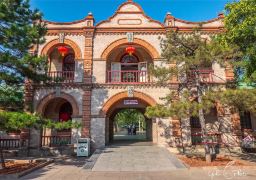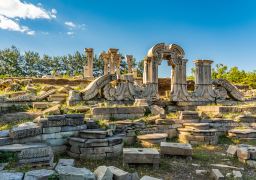Jie Tai Temple, along with Tan Zhe Temple, is one of the two major Buddhist temples in Western Beijing. The temple is known for its well-preserved Ming Dynasty-built platform for precepts, which is of significant scale and status. It also features garden architecture, such as the Peony Courtyard, making it an excellent place to visit for blessings, admiring ancient pines, and photographing flowers.

The temple’s layout is modest in size and roughly circular, spanning two to three hundred meters in diameter. Unlike typical Buddhist temples, the buildings are irregularly scattered rather than symmetrically arranged. A leisurely stroll and exploration of the temple grounds typically takes around two hours.
The Precepts Platform Hall is the primary attraction at Jie Tai Temple. This platform is a distinctive Buddhist architectural feature used for administering precepts to Buddhist personnel. The platform’s different levels correspond to different levels of precepts that can be administered, and this one is capable of granting the high Bodhisattva precepts. It has also served emperors through several dynasties, highlighting its high status. The platform stands approximately 3.5 meters tall, constructed from white marble, with 113 uniquely expressive statues of precept gods carved around its perimeter and a majestic Buddha statue atop.
Another scenic spot within Jie Tai Temple is the Peony Courtyard, which was built during the residence of Prince Gong of the Qing Dynasty.It is a serene garden with numerous peony plants that bloom beautifully from April to May, creating a very elegant and beautiful scene. Besides the flowers, the garden’s architecture is also exquisite and worth visiting. The temple also features other structures such as the Great Bell Pavilion, a thousand-year-old wooden carving of Maitreya Buddha, the Mahavira Hall, the Guanyin Hall, and the Guan Yu Hall. Many of these structures were built during the Liao Dynasty and are well-preserved. The architectural styles differ from those of later structures like the Forbidden City and are worth appreciating. In addition to the garden architecture, the temple’s flora is also a point of interest. Jie Tai Temple houses several ancient pine trees over a thousand years old, each with a unique and distinctive shape, highly admired in the capital. Among the halls, there are also various flowers such as lilacs and peonies, making it an excellent spot for photography during spring and summer. The temple offers vegetarian meals daily at noon for visitors and worshippers, which can be optionally tried. The meals consist of rice, steamed buns, and small bowls of vegetarian dishes, with a decent taste. The meals are not strictly charged but are based on voluntary contributions, though most people contribute a small amount. Opening hours are from 08:30 to 16:45, every day from January 1st to December 31st. Preferential policies include free admission for children under 1.2 meters tall or under 6 years old, free admission for seniors aged 60 and above with their own ‘Beijing Tong – Elderly and Disabled Assistance Card’, half-price admission for those without the card, free admission for retired personnel with valid documents, free admission for active-duty military and firefighters with valid documents, and free admission for the disabled with valid documents.Visiting Jie Tai Temple: Student Discounts and Dining Etiquette
Admission Discounts for Students:
– Full-time primary, middle, and high school students with valid student cards are eligible for half-price admission. (Graduate and adult education students are not included in this offer.)
– Please note that these preferential policies must be availed through on-site purchase.
Parking Information:
– Jie Tai Temple Park Parking Lot is located in Yongding Town, Mentougou District, Beijing.
– The parking lot offers 100 spots with a reference price of ¥50 per entry.
Dining Etiquette:
– When enjoying vegetarian meals within the temple, it is important to adhere to the following rules:
– Sit separately by gender.
– No talking during the meal.
Visiting Both Temples:
– Jie Tai Temple is conveniently located near Tan Zhe Temple in the northwest direction and can be easily reached by public transportation.
– Many tourists choose to visit both temples in a single trip.









